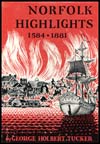Chapter 7
The Birth of "Norfolk Towne"
The date 1682 on the Norfolk City Seal, purporting to be the year the town was founded, is incorrect. The correct date is 1680, as the following information taken from the original records shows.
In June of 1680, Thomas, Lord Culpeper, the royal governor of Virginia, informed the Virginia Assembly at Jamestown that King Charles II, who had bestowed the name "The Old Dominion" on Virginia because of its loyalty to the throne during the English Civil War, had commanded him to urge the establishment of towns in Virginia. Culpeper added that no nation had ever begun a colony without them and that no colony had ever prospered until they developed.
On the strength of this suggestion, the Assembly passed "An Act for Co-habitation and the Encouragement of Trade and Manufacture," providing that a towne be established on a fifty-acre site in each of the twenty then existing counties. In specifying the various sites for these settlements, the act provided for a town "in Lower Norfolk County on Nicholas Wise his land on the Eastern Branch of the Elizabeth River at the entrance of the Branch."
The site chose for "Norfolk Towne" was well-protected, having a fort at its western extremity which had been provided for by an act of the Assembly in 1678 and which had been built shortly thereafter. The site was also almost an island, being bounded on the west and south by the Elizabeth River and on the north and east by two creeks named Back Creek and Dun-in-the-Mire Creek, respectively. A narrow isthmus where City Hall Avenue and St. Paul's Boulevard now intersect then connected the proposed townsite with the country to the north of these two bodies of water.
On August 18, 1680, the justices of Lower Norfolk County, acting on the strength of the act passed by the Virginia Assembly two months earlier, instructed the sheriff of the county to notify John Ferebee, the county surveyor, to begin the survey of the townsite on October 7, 1680. The justices also requested that all interested citizens be notified from the pulpits of the churches of the proposed establishment of the town, adding that anyone who cared to be present when the survey began was welcome.
By October 19, 1680, the survey had been made, and Ferebee was paid "for surveying the towne land and officiating as Cl(erk) of the Militia." Exactly one year later, on October 19, 1681, Ferebee received another payment "as Clerke of the Militia & laying out the Streets of the Towne."
These were Main Street; "the street that leadeth down to the waterside," later known as Market Square, the Parade, and Commercial Place; "the street that leadeth into the woods," later known as "the street that leadeth out of town" and still later as Church Street; "the street that leadeth to the publique spring," later known as Metcalf Lane; and a small right angle of a street north of the eastern end of Main Street that later became East Street and Bermuda Street.
In the meantime, word was received that King Charles II had changed his mind about establishing towns in Virginia and had suspended the 1680 act of the Virginia Assembly on December 21, 1681, on the advice of his Privy Council. But the Lower Norfolk County justices decided to go ahead with the project anyway. And on August 16, 1682, Lieutenant Colonel Anthony Lawson and Captain William Robinson, acting on behalf of the county court, bought the already surveyed townsite with its five clearly designated thoroughfares for ten thousand pounds of tobacco in cask from Nicholas Wise the younger, a shipwright, who had inherited the land from his father, Nicholas Wise the elder, who had owned it since 1662.
Besides handling the transfer of the fifty-acre site from Wise to the county, Lawson and Robinson were appointed feoffees by the court with the power to grant each half-acre lot in the purchased area to any person who would build a dwelling or warehouse thereon and settle on each lot so granted within three months, the price of each lot in the new town being one hundred pounds of tobacco.
Chapter
8
Watching Norfolk's First Steps
Norfolk Highlights 1584 - 1881

See the "Table of Contents" for links to every chapter in Norfolk Highlights 1584 - 1881 by George Holbert Tucker.
